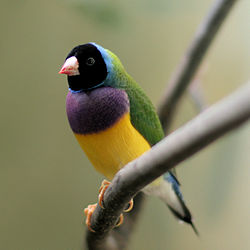| Gouldian finch | |
|---|---|
 | |
| Adult red-headed male | |
| Scientific classification | |
| Kingdom: | Animalia |
| Phylum: | Chordata |
| Class: | Aves |
| Order: | Passeriformes |
| Family: | Estrildidae |
| Genus: | Chloebia Reichenbach, 1862 |
| Species: | C. gouldiae |
| Binomial name | |
| Chloebia gouldiae (Gould, 1844) | |
 | |
| Distribution | |
| Synonyms [3] | |
| |
The Gouldian finch (Chloebia gouldiae), also known as the Gould's finch or the rainbow finch, is a colourful passerine bird that is native to Australia.












